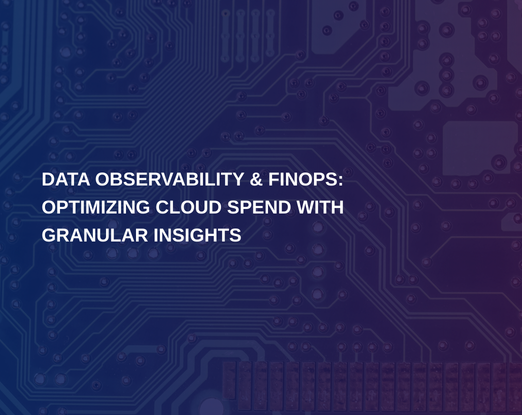In this comprehensive blog post, you will learn about the intersection of Data Observability and FinOps, understanding how these practices can significantly optimize cloud spending through granular insights. This collection of strategies, case studies, and best practices will equip you with the necessary knowledge to improve your organization’s financial management in cloud computing.
Understanding the Intersection of Data Observability and FinOps
Two critical aspects shaping modern cloud operations are Data Observability and Financial Operations (FinOps). As more organizations shift towards cloud-based frameworks, the need to optimize spending while ensuring performance and efficiency becomes paramount. This blog will dive into how combining data observability with financial management can enhance cloud performance and reduce unnecessary expenses.
Through this exploration, you will develop a rich understanding of these terms and their relevance in today’s fast-paced business landscape. Moreover, you’ll see the substantial impact of leveraging data insights to refine expenditures while maintaining optimal operational performance.
What is Data Observability?
Data Observability can be defined as the ability to automatically monitor and analyze data flows across your infrastructure. This capability allows businesses to understand everything from data migration to performance metrics accurately. At its core, it ensures that your data behaves as expected and that errors are detected in real-time.
The significance of tracking data flows lies in its ability to empower organizations to make data-driven decisions. By visualizing data paths and measuring performance, companies can quickly identify issues, thus allowing for timely intervention and better strategic planning.
Exploring FinOps: The Key to Financial Management in Cloud Usage
FinOps, short for Financial Operations, refers to a set of practices and tools aimed at managing cloud financial performance effectively. It highlights the collaboration between finance, engineering, and operations teams, breaking down silos that often lead to inefficiency and increased costs.
For successful implementation, organizations must foster a culture of financial accountability. This can be achieved by establishing best practices, which include regular monitoring of cloud expenses, implementing spend allocation measures, and infusing financial considerations into every stage of the development lifecycle.
How Data Observability Enhances FinOps Strategy
The synergy between data observability and FinOps can drastically improve an organization’s cloud financial strategy. By utilizing detailed data metrics, companies can identify spending patterns and any anomalies. This understanding facilitates proactive measures against unnecessary costs, optimizing overall cloud spend.
Consider the case where a tech company deployed data observability tools, enabling them to track resource consumption aggressively. This led to identifying underutilized resources, which were subsequently decommissioned, ultimately reducing their cloud spending significantly. Such case studies underline the tangible benefits of coupling these two domains.
Granular Insights: The Secret to Optimizing Cloud Spend
Granular insights refer to highly detailed data analytics that provide a clear view of spending habits within a cloud infrastructure. These insights are particularly relevant for FinOps, as they enable finance teams to uncover overspending and inefficiencies not visible at higher data aggregation levels.
To obtain and analyze these granular insights, organizations should implement advanced analytics tools, leverage machine learning, and create comprehensive dashboards that monitor cloud expenditures in real-time. By proactively acting on this data, it becomes possible to establish actionable strategies tailored toward addressing unnecessary costs.
Tools and Technologies for Implementing Data Observability and FinOps
Datadog, Splunk, and Looker, now offer functionalities that enable better financial management in cloud environments.
When selecting the right tool, organizations should consider various factors including integration capabilities, scalability, and user-friendliness. Moreover, choosing tools that align closely with business requirements can significantly enhance operational efficiency and financial oversight.
Future Trends: The Evolution of Data Observability and FinOps
The evolution of data observability and FinOps practices is shaping the future of cloud management. Emerging trends suggest a growing reliance on artificial intelligence and machine learning, which will enable deeper insights and more proactive cost management strategies. Additionally, as more companies embrace multi-cloud strategies, the need for standardized and unified observability tooling will crucially impact cloud financial management.
In the next few years, organizations must adapt to these trends continuously to stay competitive. By embracing new methodologies and technologies, they will optimize cloud spend while maintaining the flexibility and innovation that cloud computing offers.
Conclusion: Make Your Voice Heard
In conclusion, engaging with concepts like Data Observability and FinOps can significantly optimize cloud spending through granular insights. These strategies can empower organizations to identify inefficiencies, foster collaboration, and ultimately improve financial management in cloud computing.
Share your thoughts, comments, and experiences regarding data observability and FinOps in the comments section below! Moreover, please consider sharing this blog post on social media to contribute to community discussions and learning.
Data Observability refers to the ability to monitor and analyze data flows within an organization’s infrastructure, ensuring data behaves as expected and allowing businesses to make data-driven decisions.
FinOps, or Financial Operations, encompasses practices and tools aimed at managing and optimizing financial performance in cloud usage by fostering collaboration between finance, engineering, and operations teams.
Data Observability enhances FinOps by providing detailed metrics that help identify spending patterns and anomalies, allowing organizations to take proactive measures against unnecessary costs.
Granular insights refer to detailed analytics that provide a clear view of spending habits within cloud infrastructure, enabling finance teams to uncover inefficiencies and overspending that may not be visible at higher aggregation levels.
Tools like Datadog, Splunk, and Looker are popular options that offer functionalities for better financial management in cloud environments, aiding in data observability and FinOps practices.
Organizations should consider factors such as integration capabilities, scalability, user-friendliness, and whether the tools align closely with their business requirements.
Future trends suggest increased reliance on artificial intelligence and machine learning for deeper insights, as well as a growing need for standardized observability across multi-cloud strategies.
By combining Data Observability and FinOps, organizations can identify inefficiencies, foster collaboration across teams, and improve their financial management in cloud computing.
Regular monitoring of cloud expenses is crucial as it helps organizations maintain financial accountability and quickly identify areas of overspending or inefficiency.
